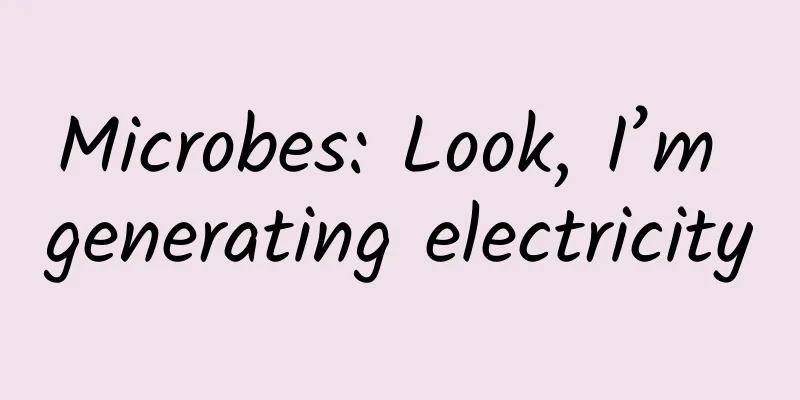Microbes: Look, I’m generating electricity

|
Microbial electrochemistry is an emerging field that combines multiple disciplines such as microbiology, electrochemistry, materials science and environmental engineering. It focuses on the interaction between microorganisms and electrodes, and how these interactions can be used to convert chemical energy into electrical energy, or vice versa. Research in this field dates back to the early 20th century, but the real breakthrough occurred in the 1980s, when scientists discovered bacteria that could directly transfer electrons from the inside of the cell to metal oxides outside the cell. Obtaining Electricity from Microorganisms: Youth Science and Technology Innovation Report Early exploration of microbial electrochemistry The earliest discovery of microbial electrochemistry can be traced back to 1910, when it was observed that microorganisms could generate voltage and current when metabolizing organic substrates. In 1962, Davis and Yarbrough proposed the concept of biofuel cells in Science magazine, which is a type of microbial electrochemical system, and its operation is based on the process of extracellular electron transfer from microorganisms to the anode. Professor Derek Lovley was invited to give an academic report Source: State Key Laboratory of Urban Water Resources and Water Environment In 1987, Professor Derek Lovley and Professor Kenneth Nealson discovered two important electroactive microbial model bacteria: Geobacter metallireducens GS-15 and Shewanella oneidensis MR-1. These discoveries laid the foundation for the development of microbial electrochemistry. Jin Binghong is teaching Source: State Key Laboratory of Urban Water Resources and Water Environment In 1999, Professor Kim Byung Hong of the Korea Institute of Science and Technology discovered that 80% of the more than 200 strains of Fe(III)-reducing bacteria were electrochemically active. This discovery greatly expanded the application potential of microbial electrochemical phenomena. Professor Bruce E.Logan in the laboratory Source:PennState In 2004, Professor Bruce E. Logan and Dr. Liu Hong of Pennsylvania State University developed a single-chamber air-cathode microbial fuel cell reactor, demonstrating the feasibility of using microbial electrochemical technology for wastewater treatment and simultaneous power recovery. Application of Microbial Electrochemical Technology In recent years, the application of microbial electrochemical technology in the field of environmental science and engineering has gradually increased, including wastewater treatment, nutrient recovery, microbial electrochemical remediation, microbial electrochemical synthesis, etc. These technologies can not only treat organic pollutants in wastewater, but also recover energy and even produce high value-added chemicals. Microbial electrochemical technology provides electricity for lighting in public toilets Source: ChemElectroChem Modern research continues to explore new applications for microbial electrochemical systems, such as desalination, biogas conversion to methane, biosensors, etc. In addition, researchers are exploring how to improve the energy efficiency of these systems and the possibility of large-scale production. Although microbial electrochemical technology has shown great potential, it still faces some challenges. For example, the low efficiency of extracellular electron transfer between electrogenic microorganisms and electrode interfaces and the weak ability to form biofilms limit the application of microbial electrochemical technology in organic matter degradation, power generation, desalination, bioremediation and biosensing. Therefore, strengthening the interaction between electrogenic microorganisms and electrode interfaces has been a major research hotspot in the past few years. Researchers have developed a variety of strategies to enhance the interaction between microorganisms and electrodes, including the transformation of cells through synthetic biology, the modification of cells with conductive nanomaterials, and the immobilization of cells on the surface of electrodes. These strategies aim to optimize or exogenously introduce the biosynthetic pathway of electron transfer elements, directly regulate the cellular electron transfer pathway, and improve the extracellular electron transfer efficiency of electrogenic microorganisms. Future prospects of microbial electrochemistry In the future, research in the field of microbial electrochemistry may focus on the following aspects: in-depth analysis of the extracellular electron transfer and biofilm formation mechanisms of electricity-producing microorganisms; development of active bioelectrochemical composite materials with advantages such as good biocompatibility, strong conductivity, large loading capacity, good stability and low cost; and based on the interaction between microorganisms and electrodes, in-depth research on the role of methods such as cells modified with conductive materials and cells immobilized on electrode surfaces in enhancing the efficiency of electron transfer between microorganisms and electrodes. In conclusion, microbial electrochemistry is a rapidly developing field that combines knowledge from multiple disciplines to provide new solutions for environmental protection and energy production. With a deeper understanding of electroactive microorganisms and the development of new technologies, microbial electrochemistry is expected to play an even more important role in the future. References: [1] Fu Jie, Li Chuanfu. Microbial fuel cells: getting energy from waste[N]. Youth Science and Technology Innovation News, 2024-07-19 (06). [2] Feng Yujie, Ren Nanqi, Li Da, He Weihua, et al. Principles and Applications of Microbial Electrochemistry (M). Science Press. 2022-07. [3]Zhang, L., Zhang, Y., Liu, Y. et al. High power density redox-mediated Shewanella microbial flow fuel cells. Nat. Commun. 15, 8302 (2024). [4]Li C, Liang D, Tian Y, et al. Sorting Out the Latest Advances in Separators and Pilot-Scale Microbial Electrochemical Systems for Wastewater Treatment: Concomitant Development, Practical Application, and Future Perspective[J]. Environmental Science & Technology, 2024. Author: Li Chuanfu, member of the editorial board of "Ke Xiaoer" of Zhejiang Science Popularization Federation, member of the China Science Writers Association, member of the Royal Society of Chemistry (MRSC), gold medal winner of Zhejiang Science Communication Competition, and one of his works was selected as one of the top ten popular science works of the year by Gansu Science Popularization Association. |
>>: Why do we need to build a space station? Written after the launch of Shenzhou 19
Recommend
US judge: WeChat ban violates user rights and will not be allowed to be enforced
After a U.S. district court urgently halted the U...
Wild boars are spotted in many places. What should you do if you encounter one?
recent, Wild boars frequently appear in many plac...
After three changes of jobs, this "Internet porn star" finally found out his last name
In early spring in Guangzhou, you can see beautif...
To be fair, if it weren't for AMD YES, Nvidia wouldn't have thrown out the 30 series nuclear bomb so early
Nvidia has thrown a nuclear bomb into the graphic...
What do we do when we promote our app?
Abstract : I am quite familiar with this aspect, s...
As the global market continues to decline, autonomous driving technology provider Mobileye comes to China to seek business support
Recently, Mobileye, a world-renowned provider of ...
A full-link analysis of Pinduoduo's New Year's Eve fission event
This article focuses on the disassembly of activi...
A collision of ideas caused by code review
[[236712]] At the team's iteration review mee...
PSA joins hands with Huawei to create a connected car phone to take over all car information
During the Hannover Industrial Fair (April 23-27)...
How much do you know about performance optimization?
[[196882]] 1. Introduction Recently, a new versio...
2021 Beauty and Skin Care Marketing Strategy
This may be the most comprehensive beauty and ski...
How to build an excellent entrepreneurial team? How to build a SEO team?
A professional SEO team is crucial to the operati...
New media software, what software do you need to operate short videos?
If you want to do your work well, you must first ...
Who is it? Making countless atoms sing in unison (Part 1)
Before the establishment of quantum theory, peopl...
Analysis of Perfect Diary: How should the beauty industry conduct online marketing?
In the Internet age, consumers are no longer so k...









